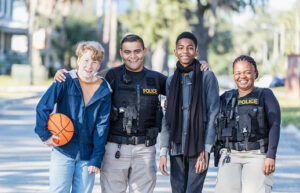
Respond to retaliatory violent disputes
A violent retaliatory dispute is a conflict between multiple people that carries on over time. A violent retaliatory dispute is characterized by confrontation and intimidation…

A violent retaliatory dispute is a conflict between multiple people that carries on over time. A violent retaliatory dispute is characterized by confrontation and intimidation…

Comprehensive youth violence prevention programs reduce gun violence by targeting individual, relational, community, and societal risk and protective factors. To prevent youth involvement or victimization…

The Credible Messenger Model partners community members who can build relationships with juveniles and adults who are in secure detention or incarceration facilities. Credible Messengers…

Focused Deterrence is a multi-faceted evidence-based approach that first identifies groups or individuals who are driving gun violence and then provides collaborative intervention strategies. Law…

Cure Violence aims to reduce violence using public health approaches. Cure leverages community partnerships and violence interrupters along with public education campaigns. Violence interrupters are…

Youth development program approaches may vary, but typically include a structured curriculum with skill-building activities delivered during school time or by community organizations out of…

Individual-level community-based services aim to target criminogenic risk factors that may lead to gun-involved crime. These services can be provided to at-risk youth prior to…

The Top Offender List training provides insight and guidance in developing a “top offender list” documenting the roughly 6% of individuals responsible for over 60%…

Street outreach workers collaborate with law enforcement agencies, often engaging youth in neighborhoods deemed as high risk for violent crime. Street outreach workers are often…

Problem-oriented policing uses the SARA Model: Scanning, Analysis, Response, Assessment. The model is supposed to support an active and ongoing process that involves identifying problems…

The goal of public awareness campaigns targeting gun violence is to increase communities’ knowledge about specific aspects of gun-involved injury. They target the specific needs…

Law enforcement agencies can create neighborhood engagement units to reach marginalized populations by collaborating with community residents, working with these residents to identify problems and…

Mentoring approaches to reduce gun violence combine elements of group-based violence intervention (focused deterrence), hospital-based programs, and violence interrupter programs to provide voluntary intensive mentoring…

Law enforcement agencies can use a wide range of approaches to identify chronic offenders and implement tailored interventions to prevent re-offending. Predicting repeat offending is…

Gun licensing laws require that individuals who buy a gun pass a background check. Licensing laws are more stringent than laws that require a background…

Gun courts are used to speed up the court processing and trial of crimes committed with guns or to mandate training and awareness programs for…

Hot spots policing and directed patrols are similar strategies which focus on increasing law enforcement resources in areas known to experience high rates of crime.…

Consent to search and seize programs focus specifically on the parents of youth living in high-crime areas. Police go door-to-door and ask parents for their…

Comprehensive gun violence reduction strategies combine enforcement, prevention, policy, and reentry efforts to target gun violence in communities. Approaches are tailored to the specific community…

Comprehensive anti-gang initiatives combine enforcement, prevention, and reentry efforts to target gang-related gun violence in high-crime neighborhoods. Sites that implement this approach to tailor the…